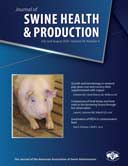Abstract:

Growth performance and hematology characteristics in pigs treated with iron at weaning as influenced by nursery diets supplemented with copper
Mark J. Estienne, PhD; Sherrie G. Clark-Deener, DVM, PhD; Kimberly A. Williams, BS
Complete article is available online.
PDF version is available online.
Objective: Determine the effects of dietary copper on growth in pigs given iron at weaning.
Materials and methods: Weanlings (n = 144) were allocated to a 2 × 2 × 2 factorial arrangement of treatments (6 pens/treatment, 3 pigs/pen). Factors were size (large or small), 100 mg intramuscular iron doses (birth or birth and weaning), and dietary copper (14.2 or 250 ppm). Average daily gain (ADG), feed intake (ADFI), and gain to feed ratio were determined for 49 days. Blood was sampled at weaning and days 7 and 49.
Results: Hemoglobin (P < .001) and hematocrit (P = .002) at weaning were less in large pigs. Pigs receiving two doses of iron had greater hemoglobin (P = .05) and hematocrit (P = .04). Hemoglobin (P = .03) and hematocrit (P = .03) were greater in pigs fed the control diet. In large pigs only, body weights at day 49 were greater (P = .05) for individuals receiving two doses of iron. The interaction between number of iron doses and diet affected many growth measures including ADG (P = .02) and ADFI (P = .04) for the overall trial. In all cases, performance was greater in copper-fed pigs receiving two doses of iron.
Implications: At weaning, larger pigs had hematology characteristics consistent with a lower iron status. Iron treatment at weaning increased hemoglobin. Copper enhanced growth only if pigs received iron at weaning. In copper-fed pigs, hemoglobin was less, possibly indicating a negative effect on iron absorption.
Keywords: nursery, iron, copper, hematology
![]() Cite as: Estienne MJ, Clark-Deener SG, Williams KA. Growth performance and hematology characteristics in pigs treated with iron at weaning as influenced by nursery diets supplemented with copper. J Swine Health Prod 2020;28(4):190-204.
Cite as: Estienne MJ, Clark-Deener SG, Williams KA. Growth performance and hematology characteristics in pigs treated with iron at weaning as influenced by nursery diets supplemented with copper. J Swine Health Prod 2020;28(4):190-204.
Search the AASV web site for pages with similar keywords.
